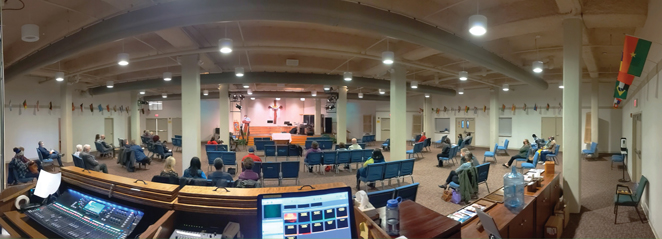Keeping faith, maintaining community – six feet apart
Church experiences during COVID-19

In March 2020, everyday life transformed – schools closed, nonessential businesses shut down, stay-at-home orders were announced. Church pews were emptied, while the need for church family connection heightened. The COVID-19 pandemic has touched all aspects of life, and communities of faith have been especially affected.
As congregations looked for solutions to what was thought would be a temporary problem, many moved services online and tried to find a suitable format.
Concepts like Zoom links, Facebook livestreams, YouTube uploads and digital tithing became common. As COVID-19 infection rates rose, employment numbers dropped, and the curve didn’t flatten. Unfortunately, it didn’t take long for disparities to appear, including some related to technology.
Studies conducted by Duke University found that large, digitally connected churches continued to grow and thrive during the pandemic, while churches with a smaller digital presence struggled – many of which were more likely rural, older, lower-income and Black. These same demographic groups were also found to be less likely to have internet access, be in worse health and economic states due to the pandemic and, in some cases, Duke found them to have a cultural resistance to technology.
Struggling to connect with members quickly created another big issue: money. Most churches already operate on tight margins. According to an April 2020 study published in Christianity Today, majority of congregations (60%) saw giving go down at the beginning of the pandemic. The decline, again, exhibited most prevalently in small rural or low-income churches.
In July 2020, Lake Institute on Faith and Giving surveyed 555 congregations from various religious traditions in the U.S. and found that congregational giving was down 4.4% from March to June 2020 compared with the same time period in 2019. In June alone, the decline was 6%. Even so, 30% of congregations raised funds for other churches and nonprofits needing support.
The pandemic also shifted messages from the pulpit. Creativity, flexibility and perseverance became essential, and churchgoers looked to sermons for inspiration.
In a survey conducted by the University of Southern California, many pastors cited higher video streaming rates and views when they addressed positive topics.
“I was used to preaching repentance and deliverance my entire career, but since Facebook Live, I’ve added more grace and empathy to most messages,” one bishop from Riverside, California, shared.

Another pastor said, “the more I speak about turning from one’s wicked ways, the fewer the views, but the more I speak on God’s blessings and protection, the viewership increases.”
People are looking for hope and security, and communities of faith are a dependable resource when so much of society feels in flux.
One church’s experience – Harrisburg Brethren in Christ
The first weekend of March 2020, one of the last “normal” weekends for many in the United States, Hank Johnson, lead pastor of Harrisburg (Pennsylvania) Brethren in Christ Church, was the keynote speaker at Stewardship University. This annual and highly anticipated Everence event in Lancaster, Pennsylvania, drew 460 participants. With worries of the coronavirus just reaching the United States, Stewardship University participants greeted each other with smiles, elbow bumps and perhaps the internal question – what could a pandemic mean for us?
For Harrisburg Brethren in Christ Church, a diverse congregation with an average attendance of around 400, it meant changing the way they thought about their values of community, outreach and spiritual growth.
“We may be physically apart during this season. Nevertheless, the Holy Spirit unites us together as one in Christ,” Hank wrote in an email to the congregation in early June 2020. “The love of God makes us family. We have been called to be God’s dynamic community here, as we share God’s love in our homes and from our screens, through our calls and video chats, and by blessing others with all that we have been blessed with – locally and globally. Our call remains. Our work remains. God’s love will keep carrying us through.”
Early on, the church turned to YouTube to post services. As the weather improved, they transitioned to meeting in person outdoors at a local park. By fall, their services moved to the church parking lot. An attempt at indoor, in-person services was forced back online when positive case numbers started to spike during the holiday season. Throughout the pandemic, live Zoom services offered opportunities for communion, group prayers and connection with friends around the world.
“We are very willing to try stuff out,” Hank said. “If it works out, great. And if it doesn’t, that’s okay too.”
Flexibility proved essential to helping outreach programs thrive, as well, despite the new challenges. The church’s food pantry served record numbers of community members after reconfiguring into a drive-thru for enhanced safety precautions. Members who were not financially struggling themselves donated their full stimulus checks straight to the deacon’s fund. It received double the typical donations in 2020.
As the lead pastor on a staff of seven, Hank also gives credit to those he works with.
“Every aspect of our ministry is thriving as best as it can under these conditions,” he said. “These are people who love Jesus, love our people, and are committed. Their sacrificial service and love is something that inspires me. They’ve been a real strength because we’ve all had to be flexible.”

Hank sees that intentionality matters, especially with so much uncertainty.
“It’s very easy to just go through the motions, but COVID has forced us to take a harder look,” he said. “People got a good look in the mirror and not all of us liked what we saw. I think we need to leave space for growth and healing.”
On March 4, 2021, Hank sent an email out to his church family and community, leading with Deuteronomy 31:12 (NIV):
“Assemble the people – men, women and children, and the foreigners residing in your towns – so they can listen and learn to fear the Lord your God and follow carefully all the words of this law."
In March 2021, Harrisburg Brethren in Christ offered in-person services, with safety restrictions, inside the sanctuary for the first time since the start of the pandemic.
“My heart is greatly encouraged by the word of the Lord in Deuteronomy 31:12,” Hank wrote. “Moses, as he transitions the people to Joshua's leadership, calls for all of the people to be gathered so they can listen, learn, and submit to God by carefully following the commandments. I am challenged by this reminder that we come together not just for fellowship and the blessing of being together. We come together to learn, grow, and be empowered to continue God’s work for us as the Harrisburg Brethren in Christ Church.”
Everence – supporting our members
Since its founding in 1945, Everence has grown out of a long tradition of church communities putting faith into action by sharing resources with each other – living together in community, in service to each other and to God. Without a doubt, this calling includes caring for the health and well-being of Everence families, friends and neighbors in the midst of the pandemic.
One way Everence supported churches and their ministries was through the COVID-19 Congregational Relief Fund. A joint effort with Mennonite Disaster Service and Mennonite Central Committee U.S., the Fund provided grants to help churches meet financial needs (such as rent, mortgage payments, utilities or staff salaries) or to assist church families and members recover from COVID-19 hardships. Approximately 90% of the initial seed money funded grants for churches with historic Anabaptist roots and relationships – many of which were racially and ethnically diverse congregations serving communities and households that are underbanked, underinsured and/or uninsured. The remaining 10% of the original funding went to support churches in Africa, Asia, Latin America and the Caribbean through the Mennonite World Conference Global Sharing Fund.

For 2020, Everence also doubled the amount of eligible Sharing Fund grant money available to congregations with an Everence stewardship advocate. This change was designed to help churches assist members or community individuals facing serious financial needs due to COVID-19, including pastors who lost income due to reduced giving in the midst of the pandemic.
Adjusting to the new normal
Church may look different when they return to in-person worship. Leaders may need to adapt to fewer people attending in-person worship or find new ways to welcome people who discovered their churches online during the pandemic.And others will need to decide if they should continue offering online worship options.
Whatever the outcome for each individual church, the pandemic’s impact will be felt by virtually all for years to come.
